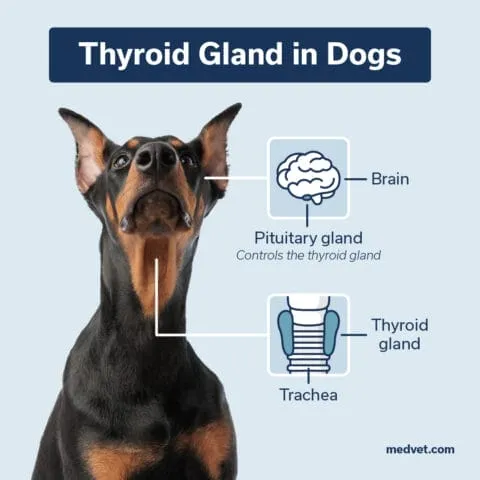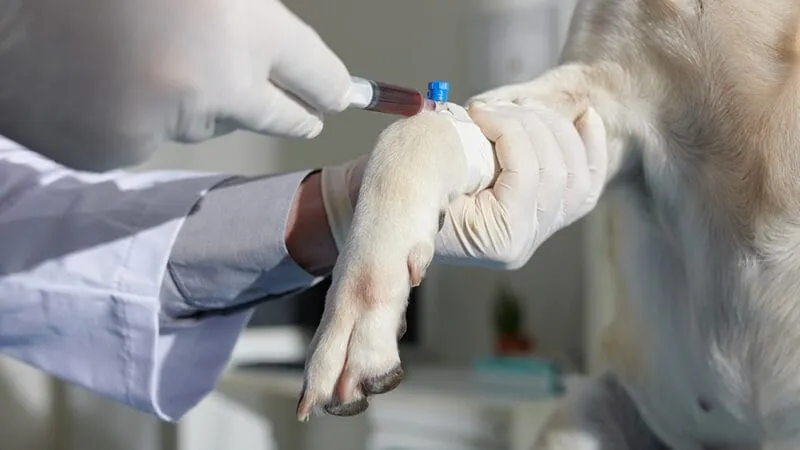The thyroid gland is a crucial endocrine organ, vital for regulating metabolism, growth, and overall bodily development in dogs. Thyroid disorders are unfortunately common in our canine companions. A thorough understanding of thyroid function, recognizing the symptoms of thyroid disease, knowing how it’s diagnosed, and being aware of treatment options are paramount for effectively managing your dog’s health and ensuring they lead a happy, healthy life.
The thyroid gland, situated in the neck near the trachea, consists of two lobes, each residing on either side of the windpipe. Its activity is governed by the pituitary gland, located at the base of the brain. This remarkable gland consistently releases hormones into the bloodstream, acting as the body’s internal “furnace” and dictating the pace of numerous physiological processes, including metabolism – how efficiently cells convert energy. The primary hormones produced are thyroxine (T4) and triiodothyronine (T3).
When a dog’s thyroid gland malfunctions, this “furnace” can either accelerate or decelerate. In dogs, hypothyroidism stands out as one of the most prevalent thyroid disorders. This condition arises when the thyroid gland fails to produce sufficient thyroid hormone, leading to a significant slowdown in the dog’s metabolic rate. It’s important to note that thyroid disorders can develop insidiously; by the time a diagnosis is made, a dog might have already lost up to 75% of its thyroid tissue without any apparent outward signs.
 Thyroid gland in dogs
Thyroid gland in dogs
Recognizing the Signs of Canine Hypothyroidism
The manifestations of hypothyroidism in dogs can be varied and often subtle, presenting a diagnostic challenge when relying solely on visible symptoms. Nevertheless, several common signs warrant attention from vigilant pet owners:
- Unexplained Weight Gain: A notable increase in weight can occur despite no alteration in the dog’s diet or caloric intake.
- Lethargy and Decreased Activity: Affected dogs frequently exhibit a marked reduction in their energy levels, appearing unusually tired or sluggish.
- Skin and Coat Issues: Hypothyroid dogs commonly suffer from dermatological problems, including dry, flaky skin, and often experience skin darkening or recurrent infections. Their coat quality deteriorates, leading to hair loss, typically around the flanks, thighs, neck, and tail. Furthermore, hair may regrow slowly or not at all after being clipped, a condition that can be particularly concerning for breeds like the German Shepherd, which are prone to various german shepherd skin disorders.
- Cold Intolerance: Dogs with an underactive thyroid may actively seek out warm spots and show a diminished ability to cope with colder ambient temperatures.
- Reproductive Disturbances: Female dogs might experience irregular heat cycles, while male dogs may exhibit a reduced libido.
- Other Potential Symptoms: Less frequently observed signs can include anemia (a deficiency in red blood cells), elevated blood cholesterol levels, neurological symptoms, and a slower than normal heart rate.
Underlying Causes of Canine Hypothyroidism
While the exact cause of canine hypothyroidism isn’t always definitively identifiable, two primary mechanisms are recognized:
Lymphocytic thyroiditis: This is an autoimmune disorder where the dog’s own immune system mistakenly attacks and damages the thyroid gland. Over time, this chronic autoimmune assault can destroy enough thyroid tissue to lead to insufficient hormone production.
Idiopathic thyroid gland atrophy: In this scenario, the thyroid tissue degenerates and is replaced by fat. The underlying reason for this degenerative process remains largely unknown.
Hypothyroidism tends to be more prevalent in medium to large breed dogs, typically affecting middle-aged canines between four and ten years old. While any dog can develop this condition, certain breeds exhibit a higher predisposition, including Beagles, Borzois, Boxers, Cocker Spaniels, Doberman Pinschers, Giant Schnauzers, Golden Retrievers, Irish Setters, and Rhodesian Ridgebacks. Understanding these breed predispositions can be a crucial step in identifying potential thyroid problems in dogs.
Diagnosing Hypothyroidism in Dogs
The diagnostic process for hypothyroidism generally involves a comprehensive evaluation that combines clinical observations with specific laboratory testing. Your veterinarian will begin with a detailed medical history and a thorough physical examination. Blood tests are essential for accurately assessing your dog’s hormone levels. The most common diagnostic tests include:
- Total T4 (TT4): This serves as a primary screening test for hypothyroidism. However, it’s important to note that TT4 levels can be influenced by various factors, including concurrent illnesses and certain medications.
- Free T4 (FT4) by Equilibrium Dialysis: This specialized test measures the levels of unbound T4, making it less susceptible to interference from non-thyroidal illnesses.
- Thyroid-Stimulating Hormone (TSH) Assay: This test quantifies the level of TSH. In cases of hypothyroidism, TSH levels are typically elevated because the pituitary gland attempts to compensate by stimulating the thyroid to produce more hormones.
- T3 and T4 Autoantibody Tests: These tests are instrumental in identifying autoimmune thyroiditis by detecting the presence of antibodies directed against thyroid hormones.
Many routine blood panels already include a T4 measurement, making it relatively straightforward for veterinarians to flag low thyroid hormone levels. However, due to the potential for T4 levels to be affected by other health issues or medications, additional tests are often required to definitively confirm a diagnosis of hypothyroidism.
Treatment Options for Canine Hypothyroidism
The cornerstone of treatment for hypothyroidism in dogs is hormone replacement therapy. The most commonly prescribed medication is levothyroxine, a synthetic form of thyroxine that is administered orally. This medication is FDA-approved for treating hypothyroidism in dogs. The appropriate dosage and frequency of administration are tailored to the severity of the disease and the individual dog’s response to the therapy. Treatment is typically lifelong, necessitating regular veterinary check-ups and periodic blood tests to ensure that hormone levels are consistently maintained within the therapeutic range. Effective thyroid problems in dogs treatment is key to managing the condition.
 Treatment of canine hypothyroidism for dogs
Treatment of canine hypothyroidism for dogs
Prognosis for Dogs with Thyroid Disease
The outlook for dogs diagnosed with hypothyroidism is generally very positive. With appropriate and consistent treatment, most dogs experience a significant improvement in their symptoms and can live a normal, fulfilling life. Ongoing follow-up appointments with your veterinarian are crucial for adjusting medication dosages and monitoring your dog’s overall well-being.
While hypothyroidism is not a curable condition, it is highly manageable. Early detection and prompt initiation of treatment are fundamental to effectively managing this disorder and ensuring that affected dogs maintain a high quality of life.
If you suspect your dog may be exhibiting signs of hypothyroidism, it is imperative to consult your veterinarian for a professional evaluation. In some cases, your veterinarian may refer your dog to a veterinary specialist in internal medicine for a more in-depth assessment and to discuss the most effective long-term management strategies for their health.
Visit our Pet Care Resources library for more pet health and safety information.
